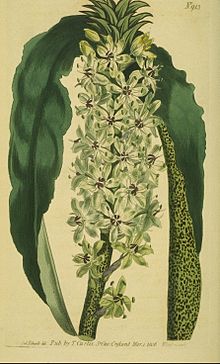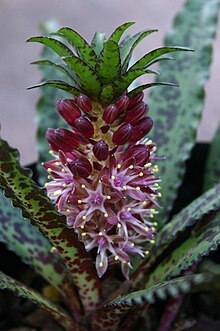Coppers
| Coppers | ||||||||||||
|---|---|---|---|---|---|---|---|---|---|---|---|---|

Wavy Flower Lily ( Eucomis autumnalis ) |
||||||||||||
| Systematics | ||||||||||||
|
||||||||||||
| Scientific name | ||||||||||||
| Eucomis | ||||||||||||
| L'Hér. |
The eucomis ( Eucomis ), and pineapple lilies called, are a genus of plants from the family of asparagus plants (Asparagaceae). The ten or so species are distributed in sub-Saharan Africa and are called Pineapple Flower (English), Pineapple Lily (English), Wildepynappel (Afrikaans), Krulkoppie (Afrikaans) or Umathunga (Zulu). Some species are used as ornamental plants .
description



Appearance and leaves
Eucomis species grow as perennial herbaceous plants that reach heights of 6 to 120 centimeters, depending on the species. These geophytes form pear-shaped or spherical, often large onions with a parchment-like, dark brown to black coating ("tunic") as persistence organs.
A few to many almost upright to prostrate leaves stand together in a basal rosette. The simple, linear to lanceolate or obscure lanceolate leaf blades are glabrous, smooth, shiny and sometimes they have purple spots or stripes. There is a parallel nerve.
Inflorescences, flowers and pollination
At the end of the more or less long, monochrome or spotted inflorescence shafts stand dense, racemose inflorescences, which contain many flowers and are crowned by a wreath of deciduous, foliage-like, whitish or greenish, sometimes purple-colored spotted bracts ( coma ) (hence the botanical Generic name and some of the common names in several languages). The spreading to more or less pendulous, stalked flowers are in the axilla of small bracts .
The flowers of the Eucomis species are morphologically very similar to one another and differ most in their color shades. The sometimes smelling, hermaphrodite flowers are threefold. The six equally shaped, half- bloom bracts are fused at their base, spread out to almost upright and stand together in the shape of a cup or bowl. The unwaxed part of the bracts is more or less curved outwards. The colors of the bracts are white to greenish and often mottled or tinted purple, rarely ( Eucomis schijffii ) they are completely purple. There are two circles with three stamens each. The triangular broadened stamens have grown into a flat cup and fused with the base of the bracts. The three pistils have become an almost spherical, Upper permanent ovary grown. There are some ovules in each ovary chamber . The stylus is about the same length as the ovary.
The shape and color of the flowers of Eucomis schijffii and Eucomis regia suggest that they are pollinated by wasps and flies. Some species have an unpleasant smell and thus attract flies to pollinate .
Fruits and seeds
The parchment-like, egg-shaped and triangular in cross-section capsule fruits contain a few seeds in each fruit compartment. The shiny brown to black seeds are almost spherical to ovoid.
Chromosome numbers
The basic chromosome number is x = 15.
Occurrence and endangerment
The genus Eucomis is widespread from southern tropical Africa to South Africa. Three types are floral elements of the Capensis .
Nine species thrive in summer rain areas . Only Eucomis regia thrives in winter rain areas. Most species occur only or mainly at higher altitudes in mountainous to subalpine altitudes on meadows.
Some species are on the Red List of Endangered Species in South Africa: “Vulnerable” = “endangered” is Eucomis vandermerwei . Eucomis bicolor and Eucomis pallidiflora subsp. pole-evansii are considered to be "Near Threatened" = "low risk". Eucomis humilis , Eucomis schijffii and Eucomis pallidiflora subsp. pallidiflora are rated “Least Concern” = “not at risk” in South Africa.



Systematics
The genus Eucomis was established in 1788 by Charles Louis L'Héritier de Brutelle in the 17th volume of his Sertum Anglicum . The generic name Eucomis is derived from the Greek word Eukomos ( eu = good and come = hair) and means "beautifully hairy", which refers to the leaves that crown the inflorescence. Eucomis L'Hér. nom. cons. is conserved according to the rules of the ICBN (Vienna ICBN Art. 14.4 & App. III) towards Basilaea Juss. ex Lam. nom. rej. Another common synonym for Eucomis L'Hér. is Eucomea Sol. ex Salisb.
The genus Eucomis belongs to the Subtribus Massoniinae from the tribe Hyacintheae in the subfamily of the Scilloideae within the family Asparagaceae . It was previously classified in the Hyacinthaceae or Liliaceae families.
There are about ten Eucomis species:
-
Wavy flower lily ( Eucomis autumnalis (Mill.) Chitt. ): It occurs in South Africa , Swaziland , Lesotho , Botswana , Zimbabwe and Malawi . There it thrives in open grasslands, between rocks or in swamps at altitudes between 0 and 2450 meters. Stocks are falling in South Africa. There are three subspecies:
- Eucomis autumnalis subsp. amaryllidifolia (Baker) Reyneke (It is considered by some authors as a separate species, Eucomis amaryllidifolia Baker ): It occurs in the Eastern Cape.
- Eucomis autumnalis (Mill.) Chitt. subsp. autumnalis (Syn .: Fritillaria longifolia Hill , Eucomis regia L'Hér. nom. illeg., Eucomis undulata Aiton , Ornithogalum undulatum (Aiton) Thunb. , Basilaea undulata (Aiton) Mirb. )
- Eucomis autumnalis subsp. clavata (Baker) Reyneke (Syn .: Eucomis clavata Baker , Eucomis robusta Baker )
- Eucomis bicolor Baker : It occurs in KwaZulu-Natal , Free State and Lesotho at higher altitudes of up to 2800 meters. There it thrives in montane meadows along flowing waters and cool, damp rock faces in the Drakensberg . In South Africa it is considered to be "Near Threatened".
- Eucomis comosa (Houtt.) Wehrh. (Syn .: Asphodelus comosus Houtt. , Eucomis punctata L'Hér. , Fritillaria punctata (L'Hér.) JFGmel. , Ornithogalum punctatum (L'Hér.) Thunb. , Eucomea elata Salisb. , Basilaea punctata (L'Hér. ) Mirb. , Eucomis punctata var. Striata Ker Gawl. , Eucomis striata (Ker Gawl.) WTAiton , Eucomis punctata var. Concolor Baker ): It occurs in the two South African provinces of Eastern Cape and KwaZulu-Natal. The stocks are falling.
- Eucomis grimshawii G.D.Duncan & Zonn. : It occurs in the northeastern former Cape Province. It was first described in 2010.
- Eucomis humilis Baker : This endemic occurs only in KwaZulu-Natal and is “Least Concern” = “not endangered”. It thrives in montane to subalpine meadows in the Drakensberg .
- Eucomis montana Compton : It occurs in Mpumalanga and Swaziland. The stocks are falling.
-
Eucomis pallidiflora Baker : It thrives in mountain bogs and coastal grasslands. There are two subspecies:
- Eucomis pallidiflora Baker subsp. pallidiflora : It occurs in the two South African provinces of Eastern Cape and KwaZulu-Natal and is “Least Concern” = “not endangered”.
- Eucomis pallidiflora subsp. pole-evansii (NEBr.) Reyneke ex JCManning (Syn .: Eucomis pole-evansii N.E.Br. ): It only occurs in Mpumalanga and is "Near Threatened".
- Eucomis regia (L.) Aiton ( Fritillaria regia L. , Basilaea regia (L.) Mirb. , Fritillaria nana Burm.f. , Basilaea coronata Lam. , Eucomis nana (Burm.f.) L'Hér. , Ornithogalum nanum ( Burm.f.) Thunb. , Eucomea humilis Salisb. , Eucomea regalis Salisb. , Basilaea nana (Burm.f.) Mirb. , Eucomis purpureocaulis Andrews , Eucomis macrophylla Baker , Eucomis pillansii L.Guthrie , Whiteheadia nana (Burm.f.) ) JWIngram ): It occurs in the two South African provinces of the North Cape and Western Cape . It is “Least Concern” = “not at risk”.
- Eucomis schijffii Reyneke : It occurs in the two South African provinces of Eastern Cape and KwaZulu-Natal. It is “Least Concern” = “not at risk”.
- Eucomis vandermerwei Verd. : It occurs in Limpopo and Mpumalanga at altitudes between 2200 and 2500 meters and is "Vulnerable" = "at risk".
- Eucomis zambesiaca Baker : It only occurs in Limpopo and is “Least Concern” = “not endangered”.
use
Eucomis autumnalis subsp. autumnalis , Eucomis bicolor , Eucomis comosa , Eucomis pallidiflora subsp. pole-evansii (also called giant coppy lily) are used as ornamental plants. In frost-free areas they are used in parks and gardens, and in areas with frost they are cultivated as container plants. They are also suitable as durable cut flowers .
Although the onions are poisonous, preparations from Eucomis autumnalis and Eucomis vandermerwei are used in folk medicine for many diseases.
swell
- John C. Manning, Peter Goldblatt & Dee Snijman: The color encyclopedia of Cape bulbs , Timber Press, Portland and Cambridge, 2002. ISBN 0-88192-547-0 : Eucomis on pp. 154–155 (sections description, distribution and systematics )
- John Manning: Field guide to wild flowers of South Africa, Lesotho and Swaziland , 487 pages, Struik Nature, Cape Town 2009. ISBN 978-1-77007-758-4 : Eucomis on p. 90 (sections description and distribution)
Individual evidence
- ↑ a b Gordon Cheers (Ed.): Botanica. The ABC of plants. 10,000 species in text and images . Könemann Verlagsgesellschaft, 2003, ISBN 3-8331-1600-5 (therein page 356).
- ↑ a b c Eucomis autumnalis and Eucomis vandermerwei at PlantzAfrika of the South African National Biodiversity Institute = SANBI . Retrieved April 9, 2013
- ↑ a b c d e Rafaël Govaerts (ed.): Eucomis. In: World Checklist of Selected Plant Families (WCSP) - The Board of Trustees of the Royal Botanic Gardens, Kew . Retrieved September 4, 2016.
- ↑ a b c d e f g h John C. Manning, Peter Goldblatt & Dee Snijman: The color encyclopedia of Cape bulbs , Timber Press, Portland and Cambridge, 2002. ISBN 0-88192-547-0 : Eucomis on p. 154 -155
- ↑ a b c d e John Manning: Field guide to wild flowers of South Africa, Lesotho and Swaziland , 487 pages, Struik Nature, Cape Town 2009. ISBN 978-1-77007-758-4 : Eucomis on p. 90
- ↑ a b c Entry in the Flora of Zimbabwe . Retrieved April 8, 2013.
- ↑ a b c Entry in the Flora of Mozambique . Retrieved April 8, 2013.
- ↑ a b Eucomis at the pacificbulbsociety . Retrieved April 9, 2013.
- ↑ Peter Goldblatt, John C. Manning & Felix Forest: A review of chromosome cytology in Hyacinthaceae subfamilies Urgineoideae and Hyacinthoideae (tribes Hyacintheae, Massonieae, Pseudoprospereae) in sub-Saharan Africa. In: South African Journal of Botany . Volume 83, 2012, pp. 134–144 doi: 10.1016 / j.sajb.2012.07.023 graphic. ( Page no longer available , search in web archives ) Info: The link was automatically marked as defective. Please check the link according to the instructions and then remove this notice.
- ^ A b D. Raimondo, L. von Staden, W. Foden, JE Victor, NA Helme, RC Turner, DA Kamundi & PA Manyama, 2009: Entry in the Red List of South African Plants of the South African National Biodiversity Institute = SANBI . Retrieved April 9, 2013.
- ^ Eucomis at Tropicos.org. Missouri Botanical Garden, St. Louis, accessed April 8, 2013.
- ^ A b Eucomis in Germplasm Resources Information Network (GRIN), USDA , ARS , National Genetic Resources Program. National Germplasm Resources Laboratory, Beltsville, Maryland. Retrieved April 8, 2013.